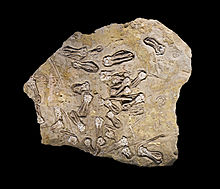Artinskian
This article needs additional citations for verification. (February 2013) |

In the geologic timescale, the Artinskian is an age or stage of the Permian. It is a subdivision of the Cisuralian epoch or series. The Artinskian lasted between 290.1 and 283.5 million years ago (Ma). It was preceded by the Sakmarian and followed by the Kungurian.[1]
Stratigraphy
The Artinskian is named after the small Russian city of Arti (formerly Artinsk), situated in the southern Ural mountains, about 200 km southwest of Yekaterinburg. The stage was introduced into scientific literature by Alexander Karpinsky in 1874.
The base of the Artinskian stage is defined as the place in the stratigraphic record where fossils of conodont species Sweetognathus whitei and Mesogondolella bisselli first appear. As of 2009, there was no agreement yet on a global reference profile (a GSSP) for the base of the Artinskian. The top of the Artinskian (the base of the Kungurian) is defined as the place in the stratigraphic record where fossils of conodonts Neostreptognathodus pnevi and Neostreptognathodus exculptus first appear.
Palaeontology
Amphibians
| Amphibians of the Asselian | ||||
|---|---|---|---|---|
| Taxa | Presence | Location | Description | Images |
| Boskovice Furrow, Czech Republic | ||||
References
- ^ See Gradstein et al. (2004) for a detailed geologic timescale
Literature
- Gradstein, F.M.; Ogg, J.G. & Smith, A.G.; 2004: A Geologic Time Scale 2004, Cambridge University Press
External links
- GeoWhen Database - Artinskian
- Upper Paleozoic stratigraphic chart at the website of the subcommission for stratigraphic information of the ICS
